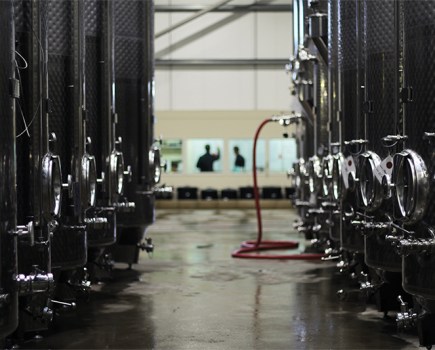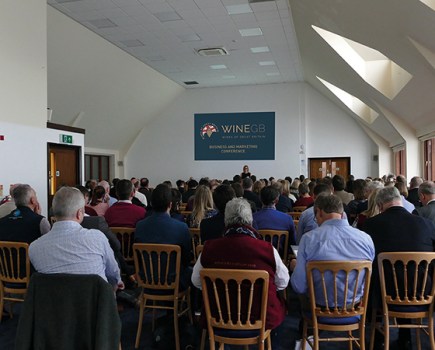Stephen Skelton MW, gathers voluntarily submitted data from vineyards around the UK to compile an in-depth harvest report.
For vineyards across the nation, harvest 2017 will no doubt be remembered for the frosts, with some of the worst damage seen in 20 years. Nevertheless, with the weather having recovered during flowering many went on to produce good crops with high hopes for 2017 vintages.
Each year viticultural consultant, Stephen Skelton MW, www.englishwine.com, gathers voluntarily submitted data from vineyards around the UK to compile an in-depth harvest report. This year he received response from 79 vineyards, an increase from just 31 in 2016. While this remains a small percentage of the total number of commercial vineyards listed in the UK, without an official body or compulsory system in place to pull this information together, it is the most comprehensive annual report compiled on the subject.
The extremely early bud-burst, which followed a mild winter and warm start to 2017, left the country’s vines vulnerable to the prevailing threat of bitter spring frosts. With April cruelly delivering two episodes where temperatures fell below zero (-3°C in some places around 19 and 20 April and down to -7°C in some places on 26 and 27 April) vineyards across the board had to deal with varying levels of frost damage to crops.
Conditions remained favourable
“Even with considerable anti-frost resources, it was virtually impossible to protect vines, especially early budding varieties, against this degree of frost and many vineyards lost all their primary buds and shoots and with them, the crop,” said Mr Skelton in his UK Harvest Report 2017.
After some further frosts in early May, the weather took a positive turn, remaining sunny and clear for much of May and early June. According to Mr Skelton, flowering was one of the earliest on record, having begun for many around 10 June, and conditions remained favourable with temperatures of up to 30°C in many places between 16 and 21 June.
“By the time Wimbledon started on 3 July, considered by most to be our usual flowering period, it was all over,” said Mr Skelton. “Most vineyards said it was two if not three weeks earlier than normal.”
The rest of the 2017 harvest season followed a normal weather pattern, with a few wet and windy spells. With véraison also occurring early, by the third week in September many had already started picking their early varieties and by mid-October harvest was pretty much complete.
“What was remarkable about the year, apart from the frosts and plus 30°C days in June, was that the relatively short warm spell during and after flowering was responsible for setting the size and quality of the crop,” said Mr Skelton. “Bunches were very large, compared to 2016 when they were smaller than usual, and despite the indifferent summer, sugar levels were high and acid levels decreased nicely for most vineyards.”
A tale of two halves, yields from harvest 2017 appear to have been largely dictated by the frost damage, not only across regions but also between varieties which either suffered badly or were able to recover.
While the top 25% of conventional (not organic or biodynamic) producers surveyed in Mr Skelton’s report appear to have achieved 8.95 tonnes per hectare (3.62 tonnes per acre) figures also show that yields were around 32% lower in frosted vineyards.
Area was worst hit by frost
Clear differences in some varieties’ yields between frosted and not frosted vineyards have also emerged and, alarmingly, compared to 2017 yields from not frosted vineyards, Chardonnay frosted yields appear to have seen reductions of up to 50%, Pinot noir comparable yields were reduced by around 43% and Meunier around 32%.
Early varieties such as Bacchus and Reichensteiner, however, appear to have been able to recover from the frost and produce fruit from secondary flowers, only experiencing reductions of 9% and 12% respectively in yield across frosted sites.
From the data submitted by the 79 vineyards, the best performing varieties of the year were Regent, Rondo and Seyval blanc, all reaching the six tonnes per hectare (2.43 tonnes acre) yield figure, with Madeleine x Angevine 7672, Meunier, Phoenix and Solaris achieving five tonnes per hectare (2.02 tonnes per acre).
While Mr Skelton’s 2017 results show that the South West and the Thames & Chiltern regions were the best performers overall, the South East of England (which accounts for 54% of the UK’s planted area) was worst hit by frost.
“If there are any lessons to be learnt from these figures it is that if your vineyard is frost-prone, or has some frost-prone areas, plant them with varieties that appear to be frost hardy such as Meunier or Seyval blanc, or try some of the early red varieties that have the time to come back from being frosted to fruit on secondaries,” said Mr Skelton.
This year eight organic and/or biodynamic vineyards submitted data for Mr Skelton’s harvest report. Overall yields were much lower, achieving 3.21 tonnes per hectare, compared to 4.68 tonnes per hectare in conventional vineyards. Rondo and Seyval blanc were again star performers, with frost affected Chardonnay and Pinot noir again being the worst performers.
Despite the impact from the frosts, 2017 for conventional growers on the whole remains comparable, when looking back to 2016, with yields even higher in some areas. 2016 however was a year which witnessed low overall yields due to poor flowering.



